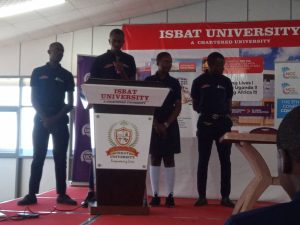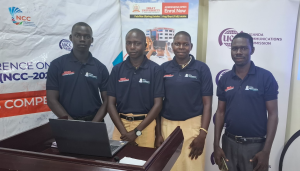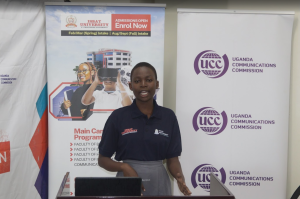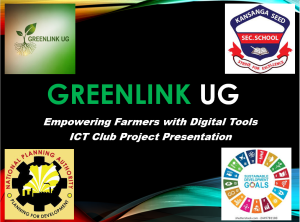No Soil, No Sun? How Ntare School ICT Club is Revolutionizing Farming in Uganda

Here in Kampala and across Uganda, the spirit of innovation is alive and well, especially within our vibrant educational institutions. Today, we’re thrilled to spotlight the incredible work coming out of the Ntare School ICT Club, a shining example of student ingenuity tackling global challenges. Their project, “UpFarm,” unveiled at the 7th National Conference on Communications (NCC) at Makerere University, is a testament to their dedication and the powerful impact of nurturing young tech talent. This groundbreaking initiative, funded by the Uganda Communications Commission (UCC), demonstrates the remarkable things our students can achieve when given the right support and opportunities.
The Ntare School ICT Club is far from a passive group; they are a dynamic hub of creativity and problem-solving. UpFarm is just the latest feather in their cap, showcasing their commitment to applying technology for social good. This project wouldn’t have been possible without the invaluable training and guidance provided by the College of Engineering, Design, Art and Technology (CEDAT) at Makerere University and KAWA (likely a partner organization, and we extend our sincere gratitude to them for their expertise). Their mentorship has been instrumental in shaping UpFarm from a concept into a promising solution. We also extend our heartfelt thanks to the Ntare School administration and the ICT department for fostering an environment where such innovative projects can thrive.
Now, let’s delve into the fascinating world of UpFarm and understand how this innovative system works, step-by-step:
UpFarm: Cultivating Crops in a Controlled Environment
UpFarm is a self-sustaining, eco-friendly system designed for crop cultivation within a controlled environment. This approach tackles the critical issues of food scarcity and the impact of traditional agriculture on our climate. Here’s a breakdown of its key components and how they work together:
- Smart Water Management: UpFarm prioritizes water conservation. It utilizes efficient sourcing methods and incorporates a recycling system. This means that water used to nourish the plants is captured, filtered, and reused, significantly reducing water consumption – a crucial advantage, especially in water-scarce regions.
- Advanced Lighting for Growth: Forget relying solely on natural sunlight! UpFarm employs specialized LED lighting, specifically blue and red spectrum lights. These wavelengths are scientifically proven to optimize photosynthesis, the process by which plants convert light into energy for growth. This controlled lighting allows for consistent and accelerated plant development, regardless of external weather conditions.
- Intelligent Climate Monitoring: Maintaining the perfect growing conditions is vital. UpFarm incorporates sensors to continuously monitor key environmental factors like heat and moisture levels. This data is then accessible through a user-friendly smartphone interface. This allows users to remotely track and adjust conditions, ensuring the plants are always in an optimal environment for healthy growth.
- Vertical Farming for Maximum Yield: Space is often a constraint in urban and even rural settings. UpFarm embraces vertical farming techniques, growing plants in stacked layers. This innovative use of space dramatically increases the number of plants that can be grown in a given area compared to traditional horizontal farming. The result? Significantly higher yields from a smaller footprint.
- Comprehensive Crop Protection: Traditional farming faces constant threats from pests, diseases, and unpredictable weather. UpFarm’s enclosed system provides a protective barrier against these challenges. By creating a controlled environment, the risk of infestations and diseases is minimized, and the plants are shielded from harsh weather conditions, leading to a remarkably high harvest yield – up to 90%!
- Sustainability and Cost-Effectiveness: UpFarm is designed with sustainability in mind. The ability to grow crops year-round in localized urban setups drastically shortens the traditional agricultural supply chain. This reduction in transportation and associated costs ultimately lowers production expenses and can lead to more affordable food for consumers.
- Powered by the Sun: Embracing renewable energy, the entire UpFarm system is powered by solar energy. This makes it a truly green and environmentally friendly solution, minimizing its carbon footprint and promoting sustainable agricultural practices.
Inspired by Innovation: Similar Projects Around the Globe
Ntare School’s UpFarm joins a growing movement of innovative agricultural solutions worldwide. Here are a few examples of similar projects that are making waves:
- Vertical Farms in Urban Centers: Companies like Plenty and AeroFarms are building massive indoor vertical farms in urban areas, utilizing similar principles of controlled environments and vertical stacking to produce fresh produce year-round.
- Hydroponic and Aquaponic Systems: These soil-less cultivation methods, often used in controlled environments, focus on delivering nutrients directly to the plant roots via water solutions (hydroponics) or integrated fish farming (aquaponics).
- Smart Greenhouses: Utilizing sensors, automation, and data analytics to optimize conditions within greenhouses, maximizing yields and resource efficiency.
Scaling Up UpFarm: Cultivating Wider Impact
The potential of UpFarm to address food security and climate change on a larger scale is immense. Here are some strategies for scaling up this innovative solution:
- Community-Based Implementation: Pilot programs can be established in local communities, empowering individuals and families to grow their own food using UpFarm technology. This can improve local food security and promote self-sufficiency.
- Partnerships with NGOs and Government Agencies: Collaborating with organizations like the World Health Organization and the World Food Program, as envisioned by the Ntare School students, can facilitate wider adoption and provide resources for implementation in regions facing food insecurity.
- Educational Outreach and Skill Development: Sharing the knowledge and skills required to build and operate UpFarm through workshops and educational programs can empower more communities to embrace this technology.
- Further Research and Development: Continuous innovation and refinement of the UpFarm system, focusing on optimizing efficiency, reducing costs, and adapting it to different crop types and environmental conditions, will be crucial for long-term scalability.
- Investment and Funding: Securing investment from government initiatives, private sector partners, and impact investors will be essential to support the manufacturing and distribution of UpFarm systems on a larger scale.
The ingenuity and dedication of the Ntare School ICT Club, with the invaluable support of UCC, Makerere University CEDAT, KAWA, and their own school administration and ICT department, offer a beacon of hope for a more sustainable and food-secure future. UpFarm is a powerful reminder that the next generation of innovators is already here, developing the solutions we need to address the world’s most pressing challenges. We eagerly anticipate seeing the continued growth and impact of this remarkable project!






